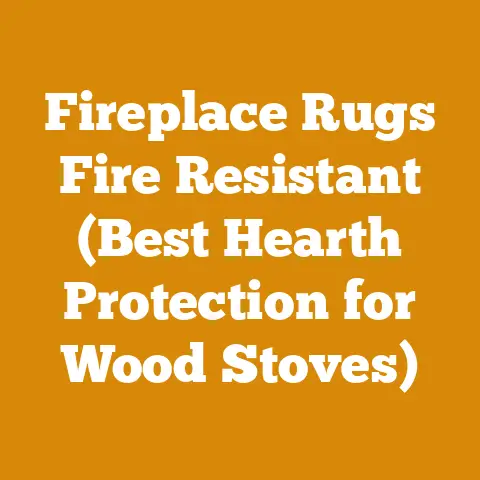How Long Does a Cord of Wood Last? (5 Expert Tips for Efficiency)
Ever notice how firewood seems to disappear faster than free donuts at a police convention?
It’s a universal truth, I think.
Figuring out how long a cord of wood will last is a bit of an art and a science.
As someone who’s spent years wrestling logs and coaxing warmth from the heart of trees, I’m going to share my secrets to make your woodpile last longer.
How Long Does a Cord of Wood Last? (5 Expert Tips for Efficiency)
Let’s dive deep into the factors that influence your firewood consumption and how to maximize your wood-burning efficiency.
Understanding a Cord of Wood
Before we start predicting the lifespan of your woodpile, let’s get crystal clear on what a cord actually is.
- What is a Cord? A standard cord of wood is defined as a tightly stacked pile measuring 4 feet high, 4 feet wide, and 8 feet long.
This equals 128 cubic feet. - Face Cord vs.
Full Cord: It’s crucial to distinguish between a “face cord” (also called a rick or stove cord) and a full cord.
A face cord is typically 4 feet high and 8 feet long, but the width varies.
So, a face cord might only be 16 inches deep, making it just a third of a full cord.
Always clarify which type of cord you’re dealing with. - Why This Matters: Misunderstanding the volume can lead to wildly inaccurate estimates of how long your wood will last.
Trust me, I’ve seen the disappointment on folks’ faces when they realize their “cord” is only half what they expected.
Factor #1: Climate and Heating Needs
This is the big one.
Your climate and how much you rely on wood for heating will drastically impact how long a cord lasts.
- Heating Degree Days (HDD): HDD is a measure of how cold a location is over a period of time relative to a base temperature, usually 65°F (18°C).
The higher the HDD, the more heating is required.
You can easily find the HDD for your location online. - Estimating Wood Consumption Based on HDD: As a general guideline, in a climate with around 5,000 HDD, a well-insulated home using a wood stove as a primary heat source might burn through 3-5 cords of wood per winter.
In colder climates (7,000+ HDD), that number can easily jump to 6-8 cords or even more. - My Experience: I live in a region with around 6,000 HDD.
I heat my 1,800 sq ft home primarily with wood, and I typically burn about 4 cords each winter.
However, I’ve spent years optimizing my heating system and wood-burning practices. - Actionable Step: Find the Heating Degree Days for your location.
Consider how well your home is insulated and how much you rely on wood heat.
This will provide a baseline for estimating your wood consumption.
Factor #2: Wood Species and BTU Value
Not all wood is created equal.
The type of wood you burn significantly affects how much heat it produces.
- BTU (British Thermal Unit): BTU is the standard unit for measuring heat output.
The higher the BTU rating, the more heat the wood generates per unit of volume. - High-BTU Wood Species: Hardwoods like oak, maple, beech, and ash are known for their high BTU content.
They burn hotter and longer than softwoods.
Oak, for example, can have a BTU rating of around 28 million per cord. - Low-BTU Wood Species: Softwoods like pine, fir, and spruce burn faster and produce less heat.
They are better suited for kindling or shoulder-season fires.
Pine might only have a BTU rating of around 20 million per cord. - The Importance of Density: Density is closely related to BTU.
Denser woods contain more energy per unit volume. Wood Species Chart (Approximate BTU per Cord):
- Oak: 28 million BTU
- Maple: 24 million BTU
- Beech: 23 million BTU
- Ash: 24 million BTU
- Birch: 20 million BTU
- Pine: 20 million BTU
- Fir: 18 million BTU
- My Tip: If you have a choice, prioritize hardwoods for your main heating needs.
Softwoods can be useful for starting fires, but they won’t provide the same sustained heat. - Case Study: A friend of mine switched from burning mostly pine to primarily oak.
He reduced his wood consumption by nearly 30% while maintaining the same level of warmth in his home. - Takeaway: Knowing the BTU value of your wood species is crucial for estimating how long a cord will last.
A cord of oak will last significantly longer than a cord of pine.
Factor #3: Moisture Content: The Silent Thief of Heat
This is where many people go wrong.
Burning wood that isn’t properly seasoned (dried) can dramatically reduce its heat output and increase creosote buildup in your chimney.
- Ideal Moisture Content: The ideal moisture content for firewood is between 15% and 20%.
At this level, the wood burns efficiently and cleanly. - Why Dry Wood Matters: Green wood (freshly cut) can have a moisture content of 50% or higher.
Burning green wood wastes energy because the fire has to boil off the water before it can produce heat.
This also lowers the fire temperature, leading to incomplete combustion and increased creosote. - Creosote Dangers: Creosote is a flammable byproduct of incomplete combustion that can accumulate in your chimney.
Over time, it can become a serious fire hazard. - How to Measure Moisture Content: The best way to measure moisture content is with a moisture meter.
These are relatively inexpensive and readily available. - Seasoning Your Wood: Seasoning involves splitting the wood and stacking it in a well-ventilated area for 6-12 months.
This allows the moisture to evaporate. - My Method: I split my wood in the spring and stack it in rows with good air circulation.
I cover the top of the stack to protect it from rain and snow, but I leave the sides open to allow air to flow through. Signs of Well-Seasoned Wood:
- Cracks in the end grain
- Lighter weight compared to green wood
- A dull, grayish color
- A hollow sound when two pieces are struck together
-
Common Mistakes:
-
Stacking wood too tightly, preventing air circulation
- Not covering the wood, allowing it to reabsorb moisture
- Burning wood that hasn’t been seasoned long enough
- Data Point: Burning wood with a moisture content of 30% can reduce its heat output by as much as 25%.
- Actionable Tip: Invest in a moisture meter and check the moisture content of your firewood before burning it.
Aim for a moisture content between 15% and 20%.
Factor #4: Wood Stove Efficiency and Usage Habits
The type of wood stove you have and how you use it also play a significant role in how long a cord of wood lasts.
- EPA-Certified Stoves: EPA-certified wood stoves are designed to burn more efficiently and produce less pollution than older, non-certified stoves.
They typically have secondary combustion systems that burn off the gases and particles that would otherwise go up the chimney. - Efficiency Ratings: Look for stoves with high efficiency ratings.
Some modern stoves can achieve efficiencies of 75% or higher. - Air Control: Proper air control is essential for efficient wood burning.
Adjusting the air intake allows you to control the rate of combustion and the heat output. - Loading Techniques: How you load your wood stove can also affect its efficiency.
A top-down burn, where you light the fire at the top of the stack, can often result in a cleaner and more efficient burn. - Maintenance Matters: Regular maintenance, including cleaning the chimney and inspecting the stove for leaks, is crucial for maintaining efficiency and safety.
- My Experience: I upgraded to an EPA-certified wood stove several years ago, and I noticed a significant reduction in my wood consumption.
I also learned how to use the air controls effectively to maintain a steady, efficient burn. - Case Study: A study by the EPA found that replacing an old, non-certified wood stove with a new EPA-certified stove can reduce wood consumption by as much as 30%.
Bad Habits to Avoid:
- Overloading the stove with wood
- Leaving the air controls wide open, causing the fire to burn too hot and fast
- Burning trash or other unsuitable materials in the stove
- Pro Tip: Learn the optimal loading and burning techniques for your specific wood stove model.
Consult the owner’s manual or seek advice from a qualified stove installer. - Takeaway: Investing in an efficient wood stove and adopting proper burning habits can significantly extend the lifespan of your woodpile.
Factor #5: Insulation and Home Efficiency
Finally, the insulation and overall efficiency of your home will impact how much heat you need to generate in the first place.
- Insulation Levels: Adequate insulation in your walls, attic, and floors will help to retain heat and reduce the amount of wood you need to burn.
- Drafts and Air Leaks: Seal any drafts or air leaks around windows, doors, and other openings.
Even small leaks can significantly increase heat loss. - Window Efficiency: Consider upgrading to energy-efficient windows to reduce heat loss.
- Home Sealing: Proper home sealing will prevent heat from escaping through cracks and gaps.
- My Story: I spent a weekend caulking and weatherstripping my windows and doors.
It made a noticeable difference in the comfort of my home and reduced my wood consumption. - Energy Audit: Consider getting a professional energy audit to identify areas where you can improve your home’s energy efficiency.
- DIY Fixes: Simple DIY projects, such as adding insulation to your attic or wrapping your water heater, can also make a big difference.
- Statistics: According to the U.S.
Department of Energy, improving your home’s insulation can reduce heating costs by 10-20%. - Actionable Step: Assess your home’s insulation and identify any areas where you can improve its energy efficiency.
Sealing drafts and adding insulation can significantly reduce your heating needs.
Pulling It All Together: Estimating Your Wood Consumption
Now that we’ve covered all the factors, let’s put it all together to estimate how long a cord of wood might last for you.
- Determine Your Heating Degree Days: Find the HDD for your location.
- Assess Your Home’s Insulation: Evaluate how well your home is insulated and identify any areas for improvement.
- Choose High-BTU Wood: Prioritize hardwoods like oak, maple, or beech.
- Season Your Wood Properly: Aim for a moisture content between 15% and 20%.
- Use an Efficient Wood Stove: If possible, invest in an EPA-certified wood stove.
- Practice Efficient Burning Habits: Load your stove properly and adjust the air controls to maintain a steady, efficient burn.
Example Calculation:
Let’s say you live in a climate with 5,500 HDD, have a moderately insulated home, burn seasoned oak in an EPA-certified wood stove, and practice efficient burning habits.
In this scenario, you might expect a cord of wood to last approximately 6-8 weeks.
Important Note: This is just an estimate.
Your actual wood consumption will depend on the specific factors in your situation.
Advanced Techniques for Maximizing Wood Efficiency
For those who want to take their wood-burning efficiency to the next level, here are some advanced techniques.
- Thermal Mass: Incorporating thermal mass into your home design can help to store and release heat, reducing temperature fluctuations and improving overall efficiency.
- Rocket Mass Heaters: Rocket mass heaters are a type of wood-burning stove that is designed to burn extremely efficiently and store heat in a thermal mass.
- Wood Gasification: Wood gasification is a process that converts wood into a combustible gas.
This gas can then be burned in a highly efficient burner. - Heat Recovery Systems: Heat recovery systems can capture waste heat from your wood stove and use it to heat other parts of your home or to preheat water.
- Experimentation: Don’t be afraid to experiment with different wood species, loading techniques, and air control settings to find what works best for your specific situation.
- Continuous Improvement: Wood-burning efficiency is an ongoing process.
Continuously monitor your wood consumption and look for ways to improve your practices.
Safety First: Essential Precautions When Handling Firewood
Working with firewood involves inherent risks. Prioritize safety at every step.
- Personal Protective Equipment (PPE): Always wear appropriate PPE, including safety glasses, gloves, and sturdy footwear.
- Chainsaw Safety: If you’re cutting your own firewood, follow all chainsaw safety guidelines.
Never operate a chainsaw when you’re tired or under the influence of drugs or alcohol. - Log Splitting Safety: Use caution when splitting logs.
Wear safety glasses and gloves, and use a log splitter with appropriate safety features. - Stacking Safety: Stack your firewood in a stable manner to prevent it from collapsing.
- Chimney Maintenance: Regularly inspect and clean your chimney to prevent creosote buildup.
- Carbon Monoxide Detectors: Install carbon monoxide detectors in your home to protect against carbon monoxide poisoning.
- Fire Extinguishers: Keep a fire extinguisher readily available in case of a fire.
- Emergency Plan: Have a fire escape plan in place and practice it regularly.
- My Personal Rule: I never rush when handling firewood.
I take my time and focus on safety. - Remember: Safety is always the top priority.
Conclusion: Mastering the Art of Wood-Burning Efficiency
Determining how long a cord of wood will last is not an exact science, but by understanding the key factors and implementing these expert tips, you can significantly improve your wood-burning efficiency and make your woodpile last longer.
From climate and wood species to moisture content and stove efficiency, every detail matters.
Remember to prioritize safety, invest in quality equipment, and continuously refine your practices.
With a little knowledge and effort, you can enjoy the warmth and comfort of wood heat without breaking the bank or harming the environment.
So, go forth, stack your wood high, and stay warm!






